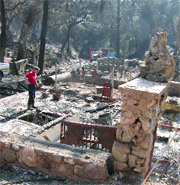 |
 |
 |
|
Coverage Concerns Loss of use coverage Recent spate of brush and forest fire losses reinforces need for coverage By Roy C. McCormick Widespread fires in fields and woodlands across the country, whether caused by lightning, careless smoking, vandalism or arson, lend new importance to loss of use coverage in homeowners policies. Home owners, landlords and renters stand to suffer great losses in the wake of windstorm and dwelling fires. The Red Cross and the Salvation Army, as well as local organizations, provide immediate but temporary care to displaced people. Long-term displacement is another matter. This is where loss of use coverage, Coverage D in most homeowners policies, comes into play. Temporary living accommodations while an insured residence is being repaired is a major subject for coverage. So is reimbursement for food expense. Transportation expense can be substantial and is within the scope of Coverage D. Coverage D also includes provisions for reimbursement for loss of rent. Our concern, however, is with expenses incurred by the insured family or individual when the covered property is not habitable. Coverage D provides a specified limit, an additional amount of insurance, that is fixed at 20% of Dwelling Coverage A in broad and special forms that are in widespread use. The loss of use coverage limit is generally 20% of Personal Property Coverage C under forms designed for renters (HO-4), and 40% of Coverage C under forms issued to condominium unit owners (HO-6). The Coverage D insurance limit, computed as indicated, is stated in the policy declarations. Coverage applies when a covered loss causes the residence premises to be unlivable. This is of such significance that its scope and conditions warrant discussion with the insured at the time insurance is being arranged, as well as at the time of loss. Additional living expense is a consequential loss, and coverage includes only increases in living expenses that are necessary to maintain the normal standard of living of the family or individual. It comes into play if a part of the insured premises is made unfit for use. In addition, when insureds are forced to leave their homes when fire threatens from adjoining property, the benefits of additional living expense coverage become clear. Additional conditions Recently, major insurers have suggested that it may become necessary to establish additional conditions for renewing policies in vulnerable locations. These conditions could include the cutting down of large trees near houses that are vulnerable to windstorm as well as fire caused by lightning strikes in drought-plagued areas. Improved roofing also might be required as a condition of coverage in individual cases. Inspections would be made to ensure compliance. Though costly, these recommendations and requirements would be seen as reasonable and necessary as a condition of insurance protection. Which persons are protected by Coverage D in homeowners policies? This can be verified by reference to the coverage particulars in the applicable policy. There are language variations. In general, the coverage is available to the same persons who have the benefit of the property and liability protection of a homeowners policy. Family living often includes an elderly parent. Such a person may occupy quarters in the main house or a separate building on the property. It could be vulnerable to wildfire or any other cause of loss. Too frequently renters do not carry HO-4, the package policy that has been designed specifically for them. This is particularly true of young people who are living away from the family home for the first time and who have little or no experience with insurance. Their parents’ agent can help by contacting them and emphasizing that apartment building fires can displace tenants who then may need costly temporary arrangements. Coverage D would come into play for those carrying renters insurance. Of course, renters of houses in outlying areas where brush fires are a threat need the same protection. In any event, discussion of loss of use and additional living expense coverage in homeowners policies can become a big plus for the image of agents and insurers! * The author |
|
|||||||||||||
| ||||||||||||||
